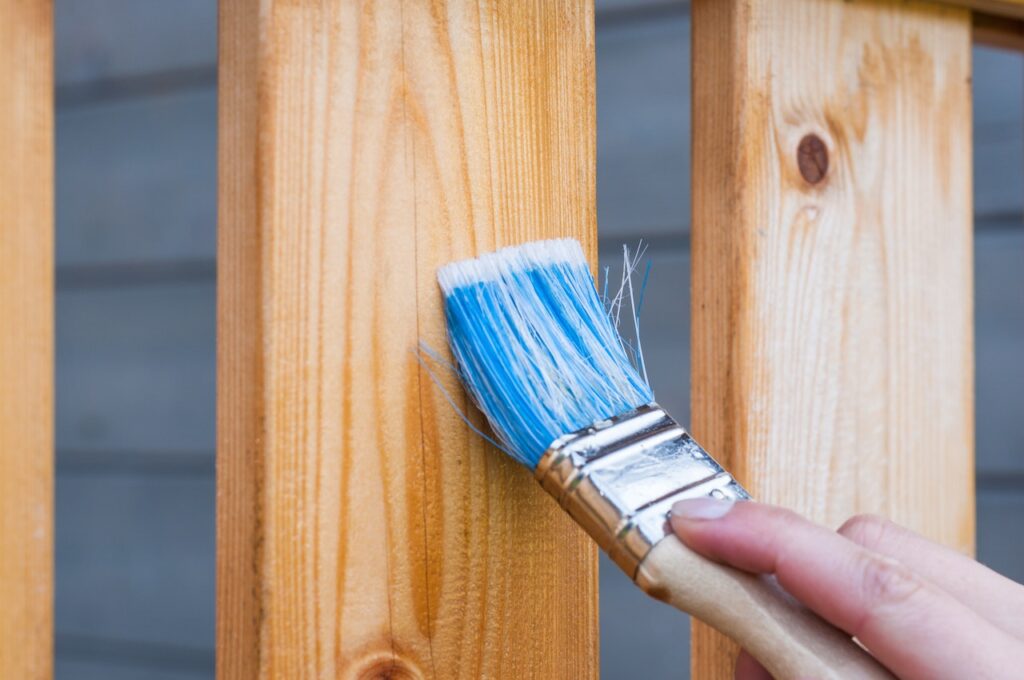A beautifully painted house not only enhances its curb appeal but also protects it from the elements and adds value to the property. Behind every stunning paint job lies the meticulous preparation process executed by professional painting contractors. Whether you are a DIY enthusiast looking to improve your painting skills or a homeowner seeking to hire a reputable contractor, understanding the secrets of their preparation process can be invaluable. In this article, we will unlock the secrets of a professional painting contractor’s preparation process to reveal the steps that ensure a flawless and long-lasting paint job.
Table of Contents
ToggleThorough Inspection
Professional painting contractors prioritize a comprehensive inspection as the first step before embarking on any painting project. This meticulous examination involves a close assessment of the surface they are about to paint, encompassing walls, trim, ceilings, and any other designated areas. The purpose of this inspection is to carefully evaluate the condition of the surfaces and identify any potential issues that may require attention before commencing the painting process.
During the inspection, the painting contractors pay keen attention to various aspects of the surfaces. They scrutinize the walls for cracks, dents, or imperfections that may hinder the quality of the paint application. Similarly, they meticulously examine the trim to detect any signs of peeling, chipping, or damage that could affect the outcome. Additionally, the ceilings are thoroughly inspected for stains, discoloration, or water damage, which may necessitate repairs or special treatment.
By conducting this thorough inspection, professional painting contractors ensure that any existing problems are identified and addressed promptly. Repairing cracks, holes, or other surface imperfections before painting is vital, as it guarantees a smooth and even paint application. This meticulous approach not only enhances the aesthetic appeal of the painted surfaces but also prevents any underlying issues from resurfacing in the future, potentially saving homeowners from costly repairs and renovations down the line.
Surface Preparation
Surface preparation is an essential and foundational step in achieving a high-quality paint job. Professional contractors understand the significance of this process as it directly affects the overall success of the project. The initial phase involves meticulous cleaning of the surface to eliminate various impurities that might hinder the proper adhesion of the paint. This typically entails the use of a mild detergent and water or a specialized cleaning solution, ensuring that dust, dirt, grease, and other contaminants are thoroughly removed.
Once the surface has been cleaned and allowed to dry, the next crucial step is to address any imperfections identified during the inspection phase. This includes the repair of cracks and holes, as well as the removal of damaged or loose paint. Skilled painters utilize top-quality fillers and putties to meticulously patch up these flaws, aiming for a seamless finish that creates a smooth and uniform surface.
Sanding
Sanding is an essential process that plays a crucial role in achieving a flawless and uniform surface for optimal paint adhesion. This step is vital for several reasons. Firstly, it helps to even out patched areas, ensuring that they blend seamlessly with the surrounding surface. Additionally, sanding smoothens rough surfaces, eliminating any imperfections that could affect the final paint finish. Furthermore, it aids in the removal of any lingering remnants of old paint, ensuring a clean and fresh canvas for the new coat. Professional painting contractors possess expertise in employing a range of sanding techniques and selecting the appropriate grits of sandpaper based on the specific condition of the surface.
Priming
Priming, an essential step often underestimated by DIY painters, holds immense significance in the world of professional painting. This crucial preparation involves applying a coat of primer, which serves a multifaceted purpose. Firstly, it adds an extra layer of protection to the underlying surface, safeguarding it from potential damage and ensuring the longevity of the paint job. Secondly, primer greatly enhances paint adhesion, ensuring a smooth and durable finish. Furthermore, it plays a pivotal role in achieving precise color accuracy, allowing the final coat to display its true vibrancy and depth. Beyond its functional advantages, primer also proves to be cost-effective in the long run.
Masking And Covering
Masking and covering are crucial techniques employed by professional painters to ensure precise and neat results while preventing paint splatters. These methods involve the use of painter’s tape and protective materials.
When it comes to masking, painters carefully apply painter’s tape along areas that should remain unpainted, such as trim, windows, and fixtures. The tape acts as a barrier, creating clean lines and preventing paint from seeping into unwanted areas. This meticulous attention to detail ensures a professional finish.
In addition to masking, painters also cover floors, furniture, and other belongings using drop cloths or plastic sheets. These protective layers shield surfaces from accidental spills or drips that may occur during the painting process. By taking this precaution, professional painters safeguard valuable items and minimize the risk of damage.
Through the combination of precise masking and thorough covering, professional painters create a controlled environment that allows them to focus on their craft while ensuring the protection of surrounding surfaces and objects.
Choosing The Right Paint
Selecting the appropriate paint is crucial for a successful painting project, with the type and quality playing pivotal roles. Seasoned painting contractors possess vast expertise in paint varieties, finishes, and brands. They carefully assess various factors, such as surface material, location (indoor or outdoor), environmental conditions, and desired outcome, to make informed choices. Opting for high-quality paint not only results in a more vibrant finish but also enhances durability, ensuring a longer-lasting effect. In essence, making informed paint choices, guided by professional insight, guarantees a superior outcome for any painting endeavor.
Applying The Paint
Applying paint is a crucial step in the painting process, and professionals utilize various tools to achieve excellent results. Brushes, rollers, and sprayers are commonly used for their unique advantages. Brushes are ideal for intricate work and precise cutting around edges, providing control and precision. On the other hand, rollers are perfect for covering large, flat surfaces quickly and evenly, saving time and effort. Additionally, sprayers offer a more efficient application on extensive exterior surfaces, ensuring a smooth and consistent coat of paint. Experienced painters understand the importance of selecting the right tool for the job and employing appropriate application techniques based on the surface type. This knowledge allows them to achieve professional-grade finishes and ensures that the paint adheres properly for long-lasting and visually appealing results.
Attention To Detail
Beyond the application of paint, professional painters pay close attention to detail throughout the entire process. They take into account minor yet crucial factors, such as weather conditions or the time of day when painting outdoors, and make necessary adjustments to ensure quality results. Moreover, they use their experienced judgment to identify areas that require additional coats and apply them with precision.
From cleaning the surface to applying the final coat, experienced painting contractors possess a wide array of expertise and skills that enable them to achieve superior results. Their attention to detail, combined with meticulous preparation work and high-quality materials, helps them deliver outstanding outcomes every time. Professional painters can craft beautiful and lasting transformations through their mastery of the trade.
Clean-Up And Final Inspection
Once the painting project is completed, professional painters take the time to perform an in-depth inspection and conduct a thorough clean-up. They inspect every inch of the surface from multiple angles to ensure that all areas have been properly covered and check that all trim lines are crisp and accurate. Additionally, they assess the overall finish for any signs of imperfections, such as bubbles, cracking, or chipping.
Finally, the painters carefully remove all masking and covering materials, dispose of them properly, and make sure that all other surfaces are clean and free from debris. This final touch up ensures a spotless environment once the painting job is done. Professional painters strive to leave their customers with outstanding results by performing a rigorous final inspection and cleaning up the area before departing.
At the end of the day, professional painting contractors bring an unparalleled level of skill, knowledge, and expertise to any project. Their attention to detail and commitment to quality allows them to deliver superior results every time. From surface preparation and application techniques to masking and covering methods, these professionals employ a wide range of best practices to create remarkable and lasting transformations. So, if you’re looking for the highest quality painting services, make sure to enlist the help of an experienced professional.
Transform Your Space With The Expertise Of A Trusted Painting Contractor!
Ready to give your home a fresh new look? Look no further than PaintMasters, Concord, California’s leading residential and commercial painting company. With over 25 years of experience, we’ve built a solid reputation for excellence in Lamorinda, Tri-Valley, Contra Costa, and beyond.
At PaintMasters, we take pride in our cutting-edge technology and unmatched expertise. Our state-of-the-art 15,000 CFM spray booth ensures a flawless finish for your cabinets. Whether you’re seeking interior or exterior painting, custom homes, deck transformations, acoustic removal, drywall repair, or texturing, our team of skilled professionals has got you covered. With PaintMasters, you can trust that your project will be done right the first time.
But our expertise doesn’t stop at painting. We’re also masters of staining, offering a wide range of options for interior and exterior walls, cabinets, doors, decks, and other woodwork. Whether you’re looking to revitalize a tired room or add a touch of style to a new space, PaintMasters is here to bring your vision to life.
What sets PaintMasters apart is our unwavering commitment to delivering flawless results. Our team combines design instinct with technical skill, ensuring every project is a masterpiece. We take pride in our professional certification and the remarkable transformations we achieve.
Don’t wait any longer to experience the transformative power of a quality paint job. Contact PaintMasters today to schedule a consultation or request an estimate online. Our dedicated team is ready to help you turn your space into a work of art. Get in touch now and let the magic begin!


